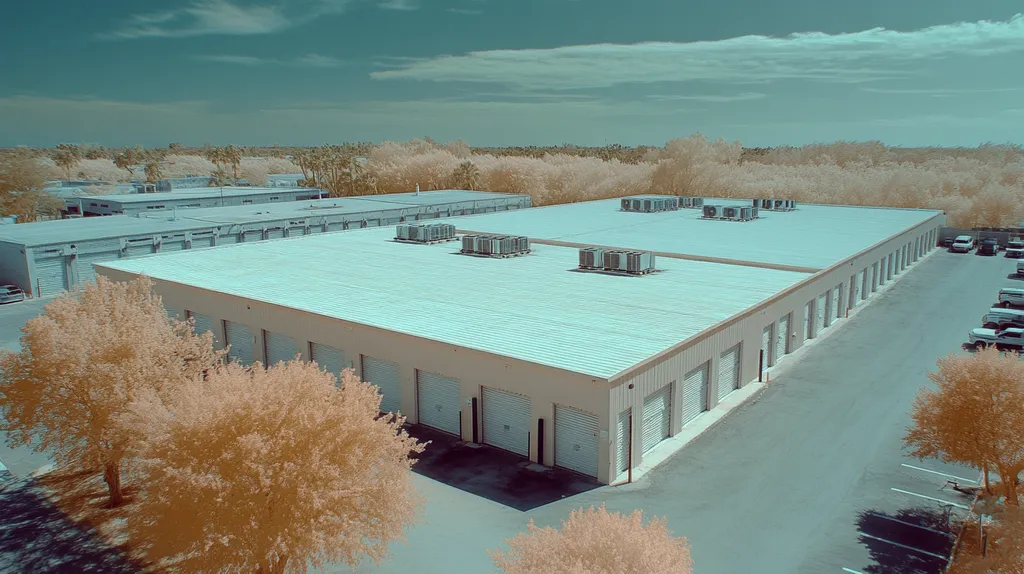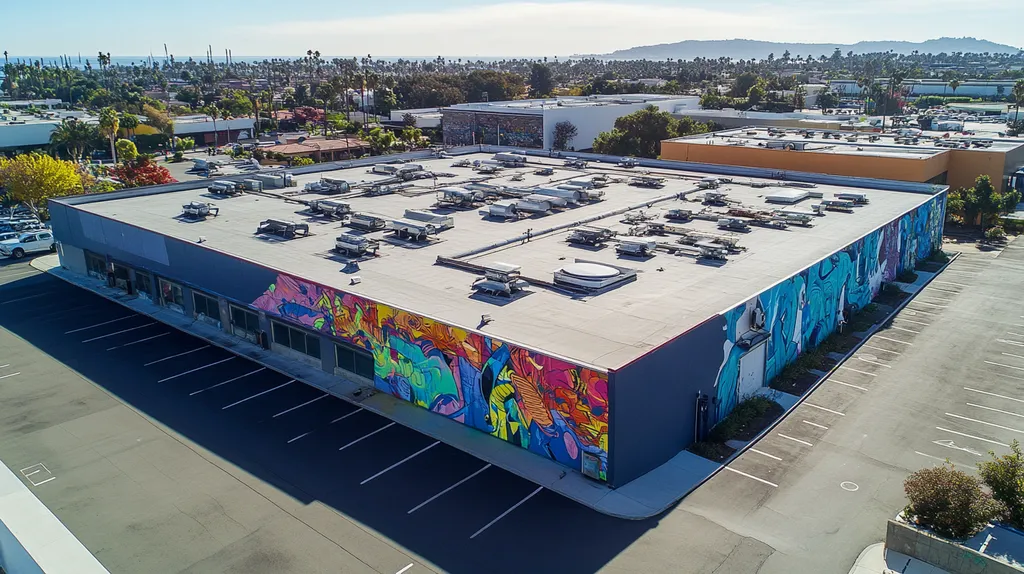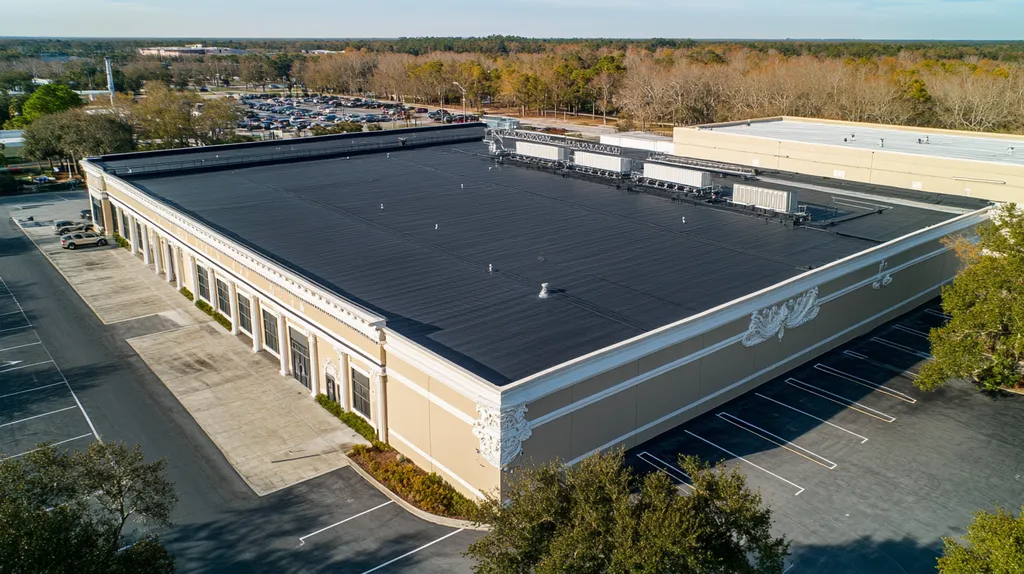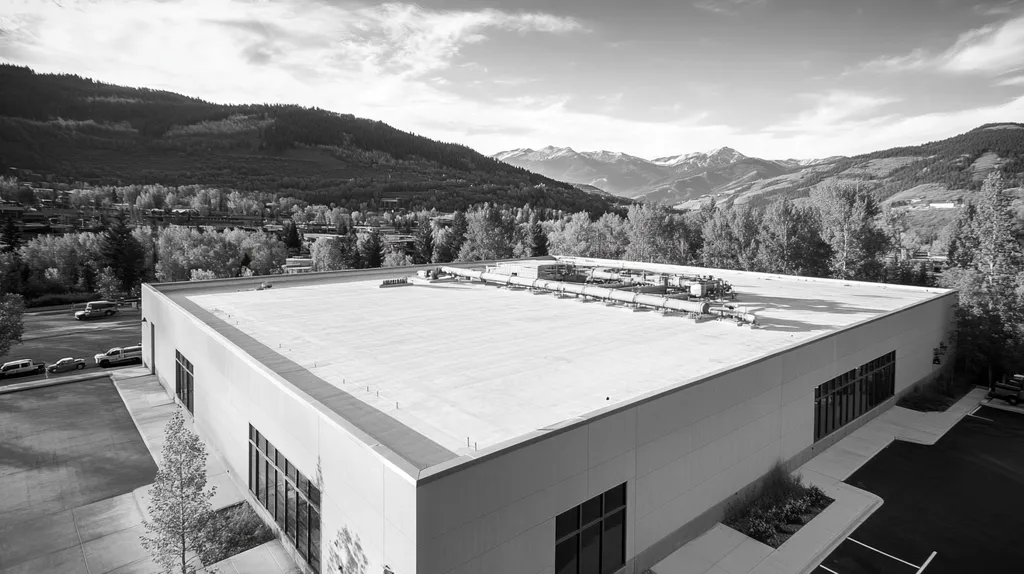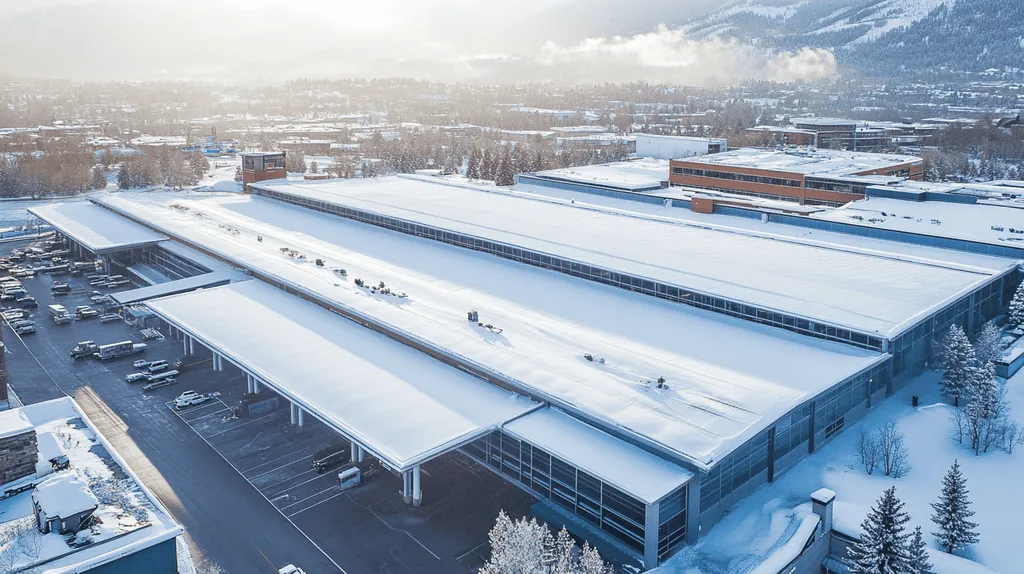In commercial roofing, material selection can mean the difference between a warranty that lasts 30 years and one that expires in just 10. Research shows that over 60% of premature roof failures stem from poor material choices, leading to millions in unnecessary repair costs annually.
For property owners and facility managers, understanding how material decisions impact warranty coverage is crucial for protecting their investment. The right choice can dramatically extend protection while reducing lifetime maintenance expenses.
This guide breaks down the critical factors that influence warranty duration, from material composition to installation requirements, helping stakeholders make informed decisions that maximize their roof’s longevity and coverage.
SECTION 1: THE BASICS EXPLAINED
When it comes to commercial roofing, selecting the right materials is vital. A poorly chosen material can lead not only to costly repairs but also to shorter warranty periods. Research indicates that roofs made from high-quality materials can endure much longer, often securing warranties that last years longer. For property owners and facility managers, grasping the connection between material choice and warranty length is essential for safeguarding their investments.
What It Is (In Plain Language)
Material choice is all about the substances used to build a commercial roof. Common materials you might encounter include TPO, EPDM, PVC, and metal. Each type brings its own set of characteristics, benefits, and potential downsides that affect not just the roof’s performance but also how long its warranty lasts.
For example, TPO roofs are celebrated for their energy efficiency, while EPDM is recognized for its long-lasting durability. Finding the right material involves weighing the cost against longevity and the specific needs of the building. Having a firm grasp of these basics is crucial for making smart decisions.
The material a roof is made from significantly influences its ability to resist harsh weather, UV rays, and wear and tear. Generally, higher-quality materials offer superior protection, which in turn leads to longer warranties from manufacturers.
Ultimately, it’s important for property owners to understand how their choice of materials directly impacts warranty coverage and the overall effectiveness of the roof.
Why It Matters (To Your Building)
The material selected for a roof has profound implications for a building’s health and operational expenses. Quality materials can stop leaks and water damage dead in their tracks—issues that frequently lead to severe structural problems. Given that roofs are the first line of defense against the elements, choosing the right material strengthens that protective layer.
Warranties are often linked to the materials used, which means that a well-informed choice can provide extensive coverage, ultimately saving money over time. For instance, a 20-year warranty on a TPO roof can be a valuable safeguard against future failures.
If property owners overlook the importance of material quality, they risk premature deterioration, leading to higher maintenance costs down the road. Conversely, opting for robust materials can enhance a building’s value and operational efficiency.
Thus, recognizing the direct link between material selection and warranty length is crucial for property owners aiming to reduce risks and maximize their investment returns.
How It Works
The chosen roofing material has a direct bearing on warranty terms, which typically cover defects, installation, and specific weather-related issues. Manufacturers evaluate product performance through rigorous testing both in lab settings and the real world to determine warranty lengths. This process highlights just how critical material selection is.
For instance, a roof made from PVC may offer a longer warranty than one made from lower-quality materials due to its enhanced performance in various conditions. This detail underscores the potential financial risks of underestimating material quality.
It’s also important to note that warranties often come with specific installation and maintenance requirements. Failure to adhere to these guidelines can void warranties, emphasizing the necessity of skilled, professional installation alongside smart material choices.
In summary, understanding how material choices influence warranty lengths enables property owners and facility managers to make informed decisions that protect their investments. Choosing wisely not only fortifies durability but also secures extensive warranty coverage.
SECTION 2: PRACTICAL APPLICATIONS
Making informed choices about roofing materials is not just a good practice—it’s crucial for the longevity and sustainability of commercial and industrial properties. The right material can significantly affect warranty length, which in turn influences how long your roof will last and how much you will spend over time. For example, a premium thermoplastic polyolefin (TPO) roof could come with a warranty lasting 20 years, while a lower-quality alternative might only offer 10 years. Understanding how different materials perform under real-world conditions can lead to smarter investments and significant future savings.
Common Uses & Examples
Various roofing materials have specific applications in commercial settings, each suited to particular needs. Single-ply membranes, such as TPO and PVC, excel in flat-roof applications due to their exceptional durability and energy efficiency. Conversely, built-up roofs (BUR) are ideal for structures requiring enhanced fire resistance. By matching materials to specific building needs, property owners can optimize warranty options and ensure better performance.
Different materials bring unique benefits that may influence their suitability. For instance, EPDM (ethylene propylene diene monomer) is celebrated for its outstanding weather resistance, making it a go-to choice in regions facing extreme climate conditions. Metal roofs, while known for their longevity—often extending beyond 30 years—may require additional insulation in cooler areas to prevent condensation issues. Evaluating these characteristics can enhance warranty length and overall roof performance.
In summary, selecting roofing materials with proven success in similar commercial environments extends their warranties and keeps maintenance costs in check. Careful consideration of each material’s intended use not only helps protect investments but also ensures the roof remains reliable over time.
When You Need It Most
The stakes become higher when extreme weather events loom on the horizon. Hurricanes, heavy snowfall, and relentless rain can place immense stress on roofs, making the selection of durable materials essential for protection. Properties situated in such risk-prone areas should focus on materials that come with extended warranties to safeguard against potential failures.
Take TPO roofs, for example: their heat-reflective properties can substantially lower energy costs during scorching summers. Highlighting these attributes during warranty discussions allows property owners to strategically prepare for environmental challenges. Investing a bit more upfront in durable materials often translates into substantial long-term savings and enhanced roof reliability.
Moreover, the timing of roof replacement or maintenance can also impact warranty benefits. Adopting preventive strategies—like selecting high-performing materials in advance of known seasonal challenges—can secure a more comprehensive warranty and mitigate risks linked to potential damage.
Interactions With Other Systems
Roof systems do not function in isolation; they interact with HVAC, plumbing, and various structural elements within a building. The compatibility of roofing materials with these systems can significantly affect overall performance and warranty longevity. For instance, choosing roofing materials that allow easy access for maintenance can extend the life of the roof as a whole.
A well-integrated roofing system must also consider drainage elements. Flat roofs lacking proper drainage can lead to water pooling, jeopardizing the warranty on even the best materials. Therefore, engaging qualified roofing professionals is crucial to evaluate how roofing decisions impact other building systems, ensuring maximum efficiency and adherence to warranty requirements.
Additionally, incorporating insulation beneath the roofing material not only boosts energy efficiency but can prolong the roof’s lifespan as well. Taking a holistic approach to roofing involves understanding how each choice interrelates with other building elements, ultimately resulting in better warranty outcomes. In essence, an effective roof system is a collective investment in the future of the building.
SECTION 3: KEY TERMINOLOGY DECODED
For property owners and facility managers navigating commercial roofing, understanding key terms is essential. Many technical terms can feel overwhelming, but grasping them ensures better decision-making when it comes to extending roof warranties and enhancing performance. By breaking down these crucial concepts, stakeholders can make informed material choices that ultimately influence both warranty lengths and the overall effectiveness of their roofs.
Essential Terms Explained
Several important terms frequently arise in discussions about roofing materials. For instance, “underlayment” is a protective layer installed beneath the main roofing material, serving as a barrier against moisture and extending the roof’s lifespan.
“R-value” is another critical term, as it measures the thermal resistance of roofing insulation. A higher R-value indicates better insulation, which helps reduce energy costs and can contribute to a longer-lasting roof.
It’s also crucial to know what “warrantable” materials are—those that meet certain performance standards set by manufacturers and qualify for warranties.
Lastly, “life cycle cost” is a term that takes into account all expenses associated with a roof over its entire life, including installation, maintenance, and repairs. This term is vital for assessing the true value of roofing investments.
Industry Jargon Translated
Many roofing terms, though they may sound technical, have straightforward meanings. For example, “thermal expansion” describes how roofing materials can change size with temperature shifts, which can impact the roof’s integrity and warranty coverage.
“Field seams” are the connections between two sheets of roofing material, crucial for ensuring waterproofing and durability. Improper installation of these seams can potentially void warranties.
Lastly, the term “low-slope roofing” refers to roofs with a minimal incline. Understanding this concept helps facility managers choose appropriate materials that align with warranty terms and conditions.
Measurement & Units Simplified
Understanding roofing measurements and units can simplify decision-making. The term “square” is commonly used to represent a 10-foot by 10-foot area of roofing, which is essential for accurate material purchasing and labor estimates.
“Mil” is another unit often discussed in terms of membrane thickness, where one mil equals one-thousandth of an inch. This measurement is directly related to material durability and affects warranty durations.
Another important concept is “pitch,” a term that describes a roof’s slope, typically expressed as a ratio like 4:12. Knowing the pitch aids in selecting suitable materials and systems.
Finally, “wind uplift” refers to the force exerted by wind over the roof surface. Understanding this measurement is crucial for material selection, ensuring warranties are met while bolstering the roof’s long-term stability.
SECTION 4: DECISION FACTORS
Choosing the right materials for a commercial roof can have significant implications for warranty length, overall costs, and roof performance. With average replacement expenses ranging from $3 to $7 per square foot, the importance of making a well-informed decision can’t be understated. Property owners and facility managers must consider immediate costs alongside long-term benefits to maximize their investments. By understanding the key factors that influence material selection, stakeholders can make smarter choices that lead to durable and reliable roofs.
Cost Considerations
The up-front cost of roofing materials is often a driving factor in the decision-making process. While low-cost options may seem appealing initially, they frequently come with shorter warranties and limited durability. For instance, traditional built-up roofing (BUR) might save money at the outset compared to high-performance thermoplastic olefin (TPO), but the long-term costs could outweigh the savings.
Investing in higher-quality materials tends to lead to reduced maintenance and repair costs over time. It’s essential for property owners to evaluate the total cost of ownership rather than simply looking at the purchase price. For example, reflective membranes can result in energy savings that bolster the financial case for investing a little more upfront.
Moreover, exploring financing options like tax incentives for energy-efficient roofing solutions can further enhance cost-effectiveness. Recognizing all financial implications helps in making the right choice—picking inferior materials can lead to expensive repairs and diminished warranty coverage.
Ultimately, weighing immediate costs against the long-term benefits is essential. A comprehensive cost analysis ensures that chosen materials not only support robust warranties but also minimize future expenses.
Performance Trade-offs
The performance characteristics of roofing materials play a critical role in their ability to withstand various environmental conditions. Different materials provide different levels of resistance against moisture, UV exposure, and thermal expansion. For example, PVC roofing is highly resistant to chemical spills, making it an excellent option for industrial applications.
However, it’s important to note that some materials may necessitate more maintenance and might not perform well in all climates. For instance, styrene-ethylene-butadiene-styrene (SEBS) modified bitumen is effective in colder areas but can struggle in hotter temperatures. Thus, aligning the roofing system with the building’s specific requirements is essential.
Performance factors can also include fire resistance, which may qualify owners for lower insurance premiums, and noise reduction, contributing to tenant satisfaction. Therefore, property owners should prioritize materials that deliver the right performance characteristics tailored to their needs, ensuring the roofing system meets warranty standards while enhancing overall building efficiency.
Lifespan & Durability Factors
Understanding the lifespan and durability of roofing materials is key when negotiating warranties. Inferior materials might fail prematurely, leading to expensive repairs and voided warranties. For instance, while asphalt shingles typically last around 15 to 30 years, metal roofs can endure for over 50 years, presenting a more reliable long-term option.
Durability also encompasses a material’s ability to withstand severe weather elements such as hail, high winds, and extreme temperatures. Materials like EPDM (ethylene propylene diene monomer) offer exceptional flexibility and strength, making them well-suited for areas that experience severe weather conditions. Selecting proven materials can greatly enhance both roof performance and warranty longevity.
Furthermore, the length of warranties is frequently tied to the expected lifespan and usage conditions. Higher-quality roofing membranes may come with warranties spanning 20 to 30 years, while lesser options usually cover much shorter periods. Being aware of these differences helps property owners make more informed investments.
In conclusion, investing in durable, long-lasting materials leads to fewer issues and lower lifecycle costs for property managers. Therefore, evaluating lifespan and durability should be a fundamental part of any roofing material decision-making process.
SECTION 5: COMMON CHALLENGES
Choosing the right roofing material is more than just a smart decision—it’s a critical factor in ensuring the longevity of your commercial roof warranty. Property owners and facility managers face serious risks when they overlook common challenges related to roofing maintenance. In fact, studies reveal that improper installation and inadequate upkeep lead to over 70% of commercial roof failures. By identifying frequent issues, recognizing warning signs, and employing preventative strategies, stakeholders can save valuable resources and protect their investments.
Frequent Problems & Solutions
One prevalent challenge in commercial roofing is inadequate drainage. Water pooling on flat roofs can quickly compromise material integrity, reducing both durability and warranty effectiveness. To tackle this, property owners should schedule regular inspections to identify and resolve drainage problems before they escalate.
Another common issue is UV damage, particularly for single-ply membranes subjected to prolonged sun exposure. This degradation can significantly shorten warranty life. To prevent such damage, utilizing UV-resistant materials or applying protective coatings can be effective solutions.
Poor installation practices are equally problematic, often leading to leaks and blisters that can undermine a roof’s integrity. Teaming up with certified roofing contractors ensures compliance with manufacturer guidelines, which is essential for maintaining warranty terms.
Finally, punctures from foot traffic and other equipment can frequently occur. Installing walkways or protective measures can mitigate this risk, helping to enhance the longevity of the roof.
Warning Signs To Watch For
Early detection of warning signs can greatly affect the lifespan of a commercial roof. A key indicator is water stains on interior ceilings or walls, typically signaling leaks. Prompt investigation is crucial to prevent further damage to the structure.
Another red flag is the appearance of blisters or bubbles in the roofing membrane, which can result from trapped moisture. This indicates that the roofing material may be in jeopardy, necessitating immediate assessment and repair of the affected areas.
Cracks or peeling materials often signal deterioration caused by UV exposure or extreme temperature fluctuations. Regular visual inspections play a vital role in catching these issues early before they worsen.
Additionally, debris accumulation, such as leaves or branches, can trap moisture and obstruct drainage systems. Keeping the roof clear is essential to avoid long-term complications that could jeopardize warranty terms.
Preventative Approaches
Implementing a preventative maintenance strategy is essential for extending the warranty length on commercial roofs. Regular inspections, ideally conducted twice a year, can help catch minor problems before they develop into significant repairs.
It’s also important to develop a comprehensive preventive maintenance plan that includes cleaning, repairs, and thorough documentation of inspections. This proactive approach not only helps extend the roof’s lifespan but also ensures compliance with warranty conditions.
Engaging certified roofing professionals for routine maintenance checks guarantees that industry best practices are followed. Their expertise can help uncover hidden issues and ensure adherence to warranty requirements.
Lastly, educating staff about the importance of keeping roofs free of debris and recognizing potential issues fosters a culture of responsibility. This awareness is critical for preserving the integrity of the roofing system and protecting the underlying investment.
SECTION 6: NEXT STEPS & RESOURCES
Making an informed choice about roofing materials isn’t just about immediate costs; it’s about safeguarding your investment for the long haul. Property owners often underestimate the impact of material selection, resulting in premature roofing failures that lead to expensive repairs and shortened warranties. By asking the right questions, understanding industry standards, and leveraging available resources, property managers can make smarter decisions that enhance the lifespan of their roofs.
Questions To Ask Providers
When evaluating roofing options, property owners should approach providers with specific questions regarding material specifications. Start by asking about the expected lifespan of the recommended materials—many manufacturers offer detailed insights into product performance and warranty options.
It’s also wise to clarify the warranty coverage specifics. Does it include labor, material defects, and environmental damage? Gaining a clear understanding of what is covered can help avoid unexpected costs later.
Inquire about any third-party certifications or compliance with established industry standards. These can be indicators of a higher-quality product that meets recognized performance benchmarks.
Lastly, don’t hesitate to ask for references from previous projects. Knowing how comparable installations have performed can greatly assist in gauging the provider’s reliability and craftsmanship.
Industry Standards & Guidelines
Familiarity with industry standards can significantly enhance the decision-making process. The Roofing Industry Committee on Weather Issues (RICOWI) provides guidelines for assessing roof performance under varying conditions, offering valuable insights into material longevity and warranty implications.
Furthermore, the American Society for Testing and Materials (ASTM) establishes testing protocols for roofing materials. Understanding these standards empowers property managers to assess quality before making a purchase.
Consulting the National Roofing Contractors Association (NRCA) is another useful step. They offer comprehensive resources that can help property owners stay informed about best practices in material selection and installation.
Staying abreast of local building codes and regulations is equally essential, as these can impact warranty conditions and mandate specific materials for compliance.
Further Learning Simplified
For property managers eager to expand their knowledge, various educational resources are accessible. Online courses and webinars centered on commercial roofing best practices can enhance decision-making skills.
Additionally, industry publications, like roofing trade journals, can provide insights into the latest materials and technologies. Regularly engaging with these publications keeps property managers informed about evolving industry standards.
Attending trade shows or local seminars is also beneficial, as these events foster networking with industry experts and provide firsthand exposure to innovative products.
Consulting with a roofing advisor or experienced contractor can offer tailored insights. Such professionals are adept at breaking down complex topics, empowering property owners to make informed and effective roofing decisions.
The Bottom Line
With over 60% of commercial roof failures stemming from poor material choices, selecting the right roofing materials has never been more critical for warranty protection.
High-quality materials can extend warranty coverage from a basic 10-year term to comprehensive 30-year protection, potentially saving property owners hundreds of thousands in replacement costs.
The data is clear: investing in premium materials like TPO or PVC, while more expensive initially, consistently delivers superior warranty coverage and reduced lifetime costs.
For facility managers and property owners, the choice is simple: either invest in quality materials now to secure longer warranties and better protection, or risk facing premature failure and extensive repair costs down the line.
The future of commercial roofing lies in making informed material choices that maximize both performance and warranty duration.
FREQUENTLY ASKED QUESTIONS
Q. How does commercial roof material choice impact warranty length?
A. The materials used play a pivotal role in determining warranty duration. High-quality roofs typically have longer warranties due to increased durability and resistance to weather-related damage. Poorly chosen materials, on the other hand, can lead to shorter warranties and higher maintenance costs.
Q. What types of commercial roofs offer the longest warranties?
A. Materials like TPO and PVC are known for their longevity and generally come with extended warranties. Premium options often provide warranties that last between 20 to 30 years, depending on the specific material and installation quality.
Q. What does ‘warrantable’ mean in relation to commercial roofs?
A. ‘Warrantable’ refers to materials that meet specific performance standards set by manufacturers. These materials qualify for warranties, ensuring they can withstand intended conditions without premature failure, thereby protecting your roof investment.
Q. How can building location affect commercial roof selection?
A. The climate and environmental risks of your building’s location significantly influence roofing material choices. Properties in areas prone to severe weather should prioritize durable, weather-resistant materials to maximize protection and ensure longer warranties.
Q. What role does installation play in commercial roof warranties?
A. Professional installation is crucial for maintaining warranty terms. Poor installation can lead to leaks or structural issues that may void warranties, making it essential to engage certified roofing professionals who follow manufacturer guidelines.
Q. How often should I inspect my commercial roof for warranty maintenance?
A. Regular inspections are recommended at least twice a year. These check-ups help identify potential issues early, ensuring compliance with warranty requirements while extending the roof’s lifespan and performance.
Q. What additional resources can help in choosing roofing materials?
A. Utilizing resources from industry organizations like the NRCA or attending trade shows can provide valuable insights. Online courses and webinars focused on commercial roofing best practices can also enhance your understanding and decision-making skills.

